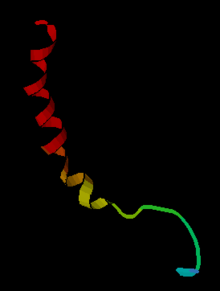Neuropeptide
From Wikipedia, the free encyclopedia
Neuropeptides are small protein-like molecules (
peptides) used by
neurons to communicate with each other. They are neuronal signaling molecules that influence the activity of the
brain
in specific ways. Different neuropeptides are involved in a wide range
of brain functions, including analgesia, reward, food intake,
metabolism, reproduction, social behaviors, learning and memory.
Neuropeptides are related to peptide hormones, and in some cases
peptides that function in the periphery as hormones also have neuronal
functions as neuropeptides. The distinction between neuropeptide and
peptide
hormone
has to do with the cell types that release and respond to the molecule;
neuropeptides are secreted from neuronal cells (primarily neurons but
also glia for some peptides) and signal to neighboring cells (primarily
neurons). In contrast, peptide hormones are secreted from
neuroendocrine cells
and travel through the blood to distant tissues where they evoke a
response. Both neuropeptides and peptide hormones are synthesized by the
same sets of enzymes, which include prohormone convertases and
carboxypeptidases that selectively cleave the peptide precursor at
specific processing sites to generate the bioactive peptides.
[1]
Neuropeptides modulate neuronal communication by acting on cell
surface receptors. Many neuropeptides are co-released with other
small-molecule
neurotransmitters. The human
genome contains about 90 genes that encode precursors of neuropeptides. At present about 100 different
peptides are known to be released by different populations of neurons in the mammalian brain.
[2] Neurons use many different chemical signals to communicate information, including
neurotransmitters, peptides, and
gasotransmitters.
Peptides are unique among these cell-cell signaling molecules in
several respects. One major difference is that peptides are not recycled
back into the cell once secreted, unlike many conventional
neurotransmitters (glutamate, dopamine, serotonin). Another difference
is that after secretion, peptides are modified by extracellular
peptidases; in some cases, these extracellular cleavages inactivate the
biological activity, but in other cases the extracellular cleavages
increase the affinity of a peptide for a particular receptor while
decreasing its affinity for another receptor. These extracellular
processing events add to the complexity of neuropeptides as cell-cell
signaling molecules.
Many populations of neurons have distinctive biochemical phenotypes.
For example, in one subpopulation of about 3000 neurons in the
arcuate nucleus of the
hypothalamus, three
anorectic peptides are co-expressed:
α-melanocyte-stimulating hormone (α-MSH),
galanin-like peptide, and
cocaine-and-amphetamine-regulated transcript (CART), and in another subpopulation two
orexigenic peptides are co-expressed,
neuropeptide Y and
agouti-related peptide (AGRP). These are not the only peptides in the arcuate nucleus;
β-endorphin,
dynorphin,
enkephalin,
galanin,
ghrelin,
growth-hormone releasing hormone,
neurotensin,
neuromedin U, and
somatostatin
are also expressed in subpopulations of arcuate neurons. These peptides
are all released centrally and act on other neurons at specific
receptors. The neuropeptide Y neurons also make the classical inhibitory
neurotransmitter
GABA.
Invertebrates also have many neuropeptides.
CCAP has several functions including regulating heart rate,
allatostatin and
proctolin regulate food intake and growth,
bursicon controls tanning of the cuticle and
corazonin has a role in cuticle pigmentation and moulting.
Peptide signals play a role in information processing that is
different from that of conventional neurotransmitters, and many appear
to be particularly associated with specific behaviours. For example,
oxytocin and
vasopressin have striking and specific effects on social behaviours, including maternal behaviour and pair bonding.
Function
Generally, peptides act at
metabotropic or
G-protein-coupled
receptors expressed by selective populations of neurons. In essence
they act as specific signals between one population of neurons and
another.
Neurotransmitters
generally affect the excitability of other neurons, by depolarising
them or by hyperpolarising them. Peptides have much more diverse
effects; amongst other things, they can affect gene expression, local
blood flow,
synaptogenesis, and
glial cell morphology. Peptides tend to have prolonged actions, and some have striking effects on behaviour.
Neurons very often make both a conventional neurotransmitter (such as
glutamate,
GABA or
dopamine) and one or more neuropeptides. Peptides are generally packaged in large
dense-core vesicles, and the co-existing neurotransmitters in small synaptic
vesicles. The large dense-core vesicles are often found in all parts of a neuron, including the
soma,
dendrites,
axonal swellings (varicosities) and nerve endings, whereas the small
synaptic vesicles are mainly found in clusters at presynaptic locations.
[citation needed]Release of the large vesicles and the small vesicles is regulated differently.
Examples
The following is a list of neuroactive peptides coexisting with other neurotransmitters. Transmitter names are shown in bold.
Norepinephrine (noradrenaline). In neurons of the A2 cell group in the
nucleus of the solitary tract), norepinephrine co-exists with:
GABA
Acetylcholine
Dopamine
Epinephrine (adrenaline)
Serotonin (5-HT)
Some neurons make several different peptides. For instance,
Vasopressin co-exists with
dynorphin and
galanin in magnocellular neurons of the
supraoptic nucleus and
paraventricular nucleus, and with
CRF (in parvocellular neurons of the
paraventricular nucleus)
Oxytocin in the
supraoptic nucleus co-exists with
enkephalin,
dynorphin,
cocaine-and amphetamine regulated transcript (CART) and
cholecystokinin.
Diabetes link
A 2006 discovery might have important implications for treatment of diabetes,.
[3][4] Researchers at the Toronto
Hospital for Sick Children injected
capsaicin into
NOD mice
(Non-obese diabetic mice, a strain that is genetically predisposed to
develop the equivalent of Type 1 diabetes) to kill the pancreatic
sensory nerves.
This treatment reduced the development of diabetes in these mice by
80%, suggesting a link between neuropeptides and the development of Type
1 diabetes. When the researchers injected the pancreas of the diabetic
mice with substance P, they were cured of the diabetes for as long as 4
months. Also, insulin resistance (characteristic of type 2 diabetes) was
reduced. These research results are in the process of being confirmed,
and their applicability in humans will have to be established in the
future. Any treatment that could result from this research is probably
years away.
Depression link
There are studies investigating the relation of neuropeptides and CNS disorders including depression.
References

No comments:
Post a Comment